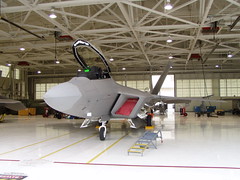 The Lockheed Martin F-22A Raptor is the best fighter jet in the world. It's faster, longer-legged, more maneuverable and packs better sensors than anything else flying. But there's one inexcusable gap in its capabilities. Unlike even older fighters, the Raptor can only receive data from external sources; it can't send. Raptor pilots have to get on the radio and tell others what they see on their radars. This at a time when rapidly sharing information between planes, ships and ground forces is the arguably the key to U.S. military power.
The Lockheed Martin F-22A Raptor is the best fighter jet in the world. It's faster, longer-legged, more maneuverable and packs better sensors than anything else flying. But there's one inexcusable gap in its capabilities. Unlike even older fighters, the Raptor can only receive data from external sources; it can't send. Raptor pilots have to get on the radio and tell others what they see on their radars. This at a time when rapidly sharing information between planes, ships and ground forces is the arguably the key to U.S. military power.
I asked the Raptor jockeys at Virginia's Langley Air Force Base about this last year and they shifted uncomfortably in their seats while feeding me some line about how voice comms work just fine. Then they quiety stressed that fixes were being planned. Now those fixes are finally firming up, according to Aerospace Daily & Defense Report:
The F-22 Raptor's "embarrassing success" has created a need for rapid modification of the fighter, says Air Force Gen. Ronald Keys, chief of Air Combat Command. ACC wants a stealthy "tactical target network" data link that can quickly pass key parameters on enemy targets without giving away its position. In initial exercises, the F-22 "was much better at [intelligence, surveillance and reconnaissance] and absorbing signals than we had anticipated," Keys says.
Keys went on to say that fixes were planned for the 2008-2013 period, by which time all 180 Raptors should be in squadron service at Langley and in Alaska and New Mexico. The general didn't exactly specify which datalink would be fitted, but recent Air Force experiments, as reported in Defense News last summer, might offer a clue:
The proposed Tactical Targeting Network Technology (TTNT) proved its mettle during a recent two-week exercise in Nevada, allowing troops and military platforms to swap information with Internet-like speed and ease. F-15 and F/A-18 fighter jets took in information about proposed targets, gathered sensor data, and sent it to ground stations to be fused with other data for more precise targeting, Boeing Advanced Systems President George Muellner said May 11. And its all machine-to-machine, Muellner said.
Machine-to-machine. That means automatic, hands-off, fast and easy. It lets the pilot focus on what pilots do best, flying airplanes, searching the sky and ground for targets with their own eyeballs, and making decisions about who to kill and when.
-- David Axe, cross-posted at Ares and War Is Boring
UPDATE 01/29/07 2:44 PM: "The stealthy Raptor fighter and intelligence-gathering aircraft is ready for war, but probably not the war we've got, Air Combat Command's chief, Gen. Ronald E. Keys, tells Aviation Week."
Essential electronic surveillance systems may be too sensitive--overwhelmed by the density of U.S. and allied emitters--to be useful in the electronically polluted environment of Baghdad, the main focus of the new U.S. military surge.
"If war breaks out, I'm sending the F-22," Keys said last week. But not for operations in Iraq or Afghanistan. "I didn't buy the F-22 for Iraq. We're looking for what can sop up intelligence, reconnaissance and surveillance [ISR] in Iraq and Afghanistan. Is the investment [of sending the F-22] worth it? Is it a good idea or just an attractive idea? Will it complicate the air component commander's problems for no gain?"









